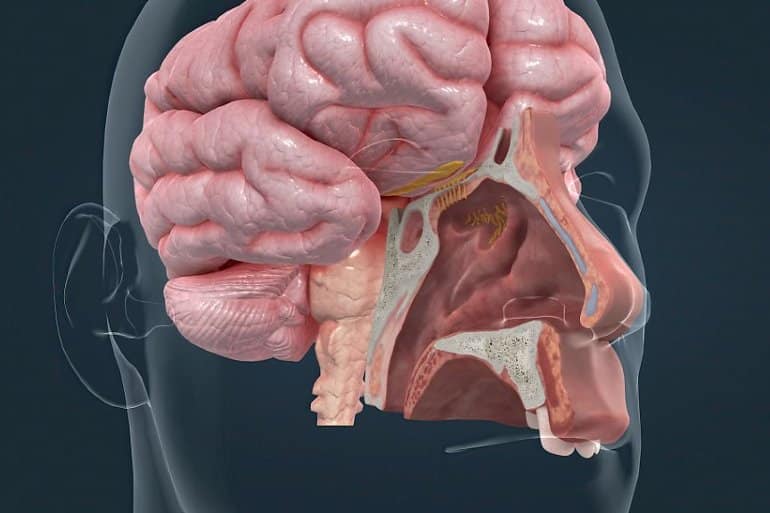Summary: Up to 90% of patients report experiencing a diminished sense of smell, even prior to the onset of other symptoms of Parkinson’s disease. A new study reveals the mechanism behind smell loss associated with Parkinson’s, reporting mouse models with olfactory impairments had severe pathology in projection neurons of the olfactory pathway. The mice also had reduced neurogenesis in the olfactory bulb.
Source: Yale
Parkinson’s disease is an illness well known for its motor symptoms—tremor, stiffness, and slowness of movement. In a new paper published in Journal of Neuroscience, researchers at Yale School of Medicine have uncovered the biological mechanism behind another common, but less studied symptom – the loss of smell.
About 75-90 percent of Parkinson’s patients report diminishing sense of smell, even prior to the onset of motor symptoms, and is now recognized a non-motor symptom of Parkinson’s disease.
Researchers at the Greer Lab and Chandra Lab at Yale School of Medicine determined the biological mechanisms behind this olfactory impairment by using an alpha-synuclein A30P mouse model used to mimic symptoms of Parkinson’s in mice.
Using buried food tests, the researchers found that the mice with later stage symptoms of Parkinson’s disease exhibited olfactory impairment. They found that those mice with olfactory deficits exhibited severe pathology in projection neurons of the olfactory pathway.

They also found these mice showed reduced neurogenesis in the olfactory bulb. In contrast, studies have shown that healthy aging brains continue to form new neurons in the olfactory bulb throughout life.
Parkinson’s patients had been reporting diminishing sense of smell for years, says corresponding author, Charles Greer, PhD, vice chair of research at the department of neurosurgery and professor of neuroscience at the Yale School of Medicine. However, since the motor symptoms of the disease were more debilitating, very little research had been done to understand the underlying biological mechanism of the olfactory dimension.
“We are excited to begin to understand the basis of anosmia in Parkinson’s disease patients,” says Sreeganga Chandra, PhD, associate professor of neurology and neuroscience.
“We set out to understand the nature of a symptom that’s associated with Parkinson’s disease that’s been largely anecdotal. People that are diagnosed with Parkinson’s disease would report loss of smell up to 10 years before their diagnosis. These findings could help in developing a very early diagnostic tool for the disease,” says Dr. Greer.
About this Parkinson’s disease research news
Author: Jennifer Chen
Source: Yale
Contact: Jennifer Chen – Yale
Image: The image is credited to Yale
Original Research: Closed access.
“α-Synuclein Pathology and Reduced Neurogenesis in the Olfactory System Affect Olfaction in a Mouse Model of Parkinson’s Disease” by Eduardo Martin-Lopez et al. Journal of Neuroscience
Abstract
α-Synuclein Pathology and Reduced Neurogenesis in the Olfactory System Affect Olfaction in a Mouse Model of Parkinson’s Disease
Parkinson’s disease (PD) is characterized by multiple symptoms including olfactory dysfunction, whose underlying mechanisms remain unclear.
Here, we explored pathologic changes in the olfactory pathway of transgenic (Tg) mice of both sexes expressing the human A30P mutant α-synuclein (α-syn; α-syn-Tg mice) at 6–7 and 12–14 months of age, representing early and late-stages of motor progression, respectively. α-Syn-Tg mice at late stages exhibited olfactory behavioral deficits, which correlated with severe α-syn pathology in projection neurons (PNs) of the olfactory pathway.
In parallel, olfactory bulb (OB) neurogenesis in α-syn-Tg mice was reduced in the OB granule cells at six to seven months and OB periglomerular cells at 12–14 months, respectively, both of which could contribute to olfactory dysfunction.
Proteomic analyses showed a disruption in endocytic and exocytic pathways in the OB during the early stages which appeared exacerbated at the synaptic terminals when the mice developed olfactory deficits at 12–14 months.
Our data suggest that (1) the α-syn-Tg mice recapitulate the olfactory functional deficits seen in PD; (2) olfactory structures exhibit spatiotemporal disparities for vulnerability to α-syn pathology; (3) α-syn pathology is restricted to projection neurons in the olfactory pathway; (4) neurogenesis in adult α-syn-Tg mice is reduced in the OB; and (5) synaptic endocytosis and exocytosis defects in the OB may further explain olfactory deficits.






